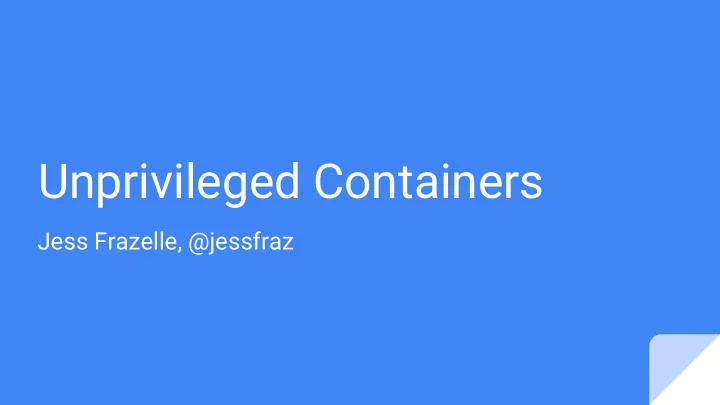

Unprivileged Containers Jess Frazelle, @jessfraz
How do containers help security? Containers are not going to be the answer to preventing your application from being compromised, but they can limit the damage from a compromise.
How do containers help security? The world an attacker might see from inside a very strict container with custom AppArmor/Seccomp profiles greatly differs than that without the use of containers.
Sandboxes Today
Chrome - Seccomp - Namespaces - Apparmor - NOT RUN AS ROOT
Containers today - Namespaces - Apparmor - Selinux - Capabilities Limiting - Cgroups - Run as root :(
How can we get to sandboxes with containers?
Back to the Basics A “container” is what we have come to call a group of namespaces and control groups applied to a process.
Control Groups (cgroups) Limit what the process can use. Resource metering and limiting. Types: memory, CPU, blkio, network, device, pid..
PID Cgroup
Namespaces Limit what the process sees. Types: pid, net, mnt, uts, ipc, user Created with clone() or unshare()
Net Namespace
UTS Namespace
IPC Namespace
PID Namespace
User Namespace
Makings of a Sandbox: Containers - Namespaces NOT RUN - Apparmor - Selinux AS ROOT - Capabilities Limiting - Cgroups
POC or GTFO
POC or GTFO
What is this sorcery? - User namespaces can be created without root. - But only if the {uid,gid}_map is mapped to the current user creating the namespace.
Not Perfect …. yet - Cgroups devices cannot be created without CAP_SYS_ADMIN
New Hotness: Cgroup Namespace - In Kernels 4.6+, not yet released, on RC5 currently - False prophet to solve all the problems, but maybe in the future.
Cgroup Namespace
What to look forward to... - Containers in a multi-tenant environment not run as root. - Sane defaults with the ability to customize for a sandbox experience. - Better designed user experiences for dealing with security policies.
Resources https://github.com/docker/docker/issues/17142 http://www.sysdig.org/falco/
Recommend
More recommend